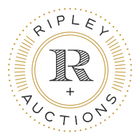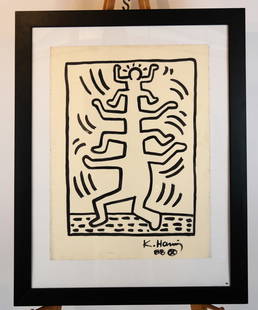
Abram Tromka, New York / Poland / Russian Federation (1896 - 1954), two old men, paint on glass, 9
Abram Tromka Sale History
View Price Results for Abram Tromka

Related Drawings
More Items in Drawings
View MoreRecommended Art
View More







Item Details
Description
Abram Tromka New York / Poland / Russian Federation (1896 - 1954) two old men paint on glass Signed upper right, and signed verso. Biography from the Archives of askART: The following, submitted October 2005 by William Woolf, is a biography of the artist created by his wife, Ann Tromka. The Tromka's were good friends of Woolf's parents. What I relate here about Tromka, from the time he came to "America" is what I remember of what he told me during our first years together. Tromka was seven years old when he came here from Poland with his family. At immigration headquarters (then called Castle Garden) the official clearing the family for entrance, suggested that since they were now in the United States, it would be a good idea for them to take an American name, suggesting "Phillips" instead of their foreign name of TROMPKA (the original spelling). So following his suggestion, they took the name of Phillips, and Phillips it remained until 1930 when Tromka changed it back, dropping the "p" for euphonious reasons. Abe related to me that when he was on the boat coming to New York, he watched a woman painting and was fascinated, and then and there decided he was going to be an artist too. He did not speak to me much about his childhood, except that it was a very difficult one, and at fifteen left home and was on his own, making do as best he could at odd jobs of every kind. His formal schooling stopped in the sixth grade and from then on he was self-taught. He discovered the Henry Street Settlement early in life and spent all of his spare time there, fascinated by the many activities he found so much to his liking. Actually the Henry Street Settlement in his youth was his home and his school. While still attending public school, his teacher recognized his talent for drawing, and called it to the attention of Lillian D. Wald, Head of the Settlement. She, too, was so impressed, that an art class was started at the Settlement, and an art teacher engaged, a Miss Nora Hamilton, an artist. Miss Hamilton taught him how to etch, and then, when he wanted an etching press of his own, and had saved enough money to buy one, he had no place for it. Miss Wald invited him to use the nurses' quarters at the Settlement as his studio, which he did at night, when the nurses were not there. (He worked during the day and that was why he concentrated on drawing and etching which could be done at night.) So he etched and drew the surroundings and the people he knew so well, and when he was seventeen years old, Miss Wald used his drawings and etchings to illustrate her book "The House on Henry Street," published by Henry Holt and Company in 1915. By 1931 the book had gone into its 5th printing and is now a collector's item. During the period from 1915 through 1927, Tromka kept on drawing and etching, and then decided to try other media. Also, during the period through 1922, he studied evenings at the Ferrer School (not now in existence) with George Bellows and Robert Henri, whose prot?g? and friend he became; they were the only teachers he had besides Miss Hamilton, mentioned earlier. When asked later who his teachers were, he would answer, "Henri, Bellows, Rembrandt, Cezanne," etc. Both Henri and Bellows were impressed by his talent and had many of his drawings and etchings. By that time, in 1923, he, with a number of friends (not artists) had a studio at 92 Fourth Avenue, in New York (now a post office), where he worked and lived for a number of years. Henri and Bellows were frequent visitors there during their lifetime. An early edition of the SURVEY GRAPHIC published a feature article about him, including illustrations of his drawings and etchings, calling him "The Rembrandt of the East Side." This was during his Henry Street Settlement period. Before he started painting, his etchings and drawings were included in many museum exhibitions throughout the country, and Julius Rosenwald, a patron of the Henry Street Settlement, purchased a number of them and presented the etching "The Sweet Potato Vendor" to the Metropolitan Museum. In 1927, Tromka met Herbert Tschudy, then curator of paintings at the Brooklyn Museum, who became his close friend. By 1932, Mr. Tschudy, who kept close touch with Tromka's development as a painter, felt that he had enough interesting work to warrant a first one-man show at the Brooklyn Museum, and during the entire summer of 1932, Tromka's paintings were on exhibition there. In 1930, Tromka asked Mr. Tschudy what he thought of the idea of his assuming his original name, and Mr. Tschudy was most enthusiastic. So for two years prior to his first one-man show at the Museum, Tromka used the name Phillips-Tromka and then finally dropped the "Phillips" and used the name Tromka only. His exhibition at the Museum was a success. Until his death in 1954, he was included in many group shows in all media at the Brooklyn Museum (etchings, drawings, oils, gouache, serigraphs) and was a prize winner there in 1946 and 1952. Two of his paintings, a gouache and an oil, were presented to the Brooklyn Museum in the 1940's, but unfortunately have not been shown for years, and I do not know what has happened to them. Tromka was on the WPA Art Project for its entire duration. He did not have to go on relief, but was invited to join to add prestige to the work being done. A number of well-known artists were on the Project in this capacity. Being on the Art Project was, according to Tromka, the happiest creative period of his life. 9 1/2"H x 7 1/2"W (sight), 12 1/2"H x 10 1/2"W (frame)
Buyer's Premium
- 30%
Abram Tromka, New York / Poland / Russian Federation (1896 - 1954), two old men, paint on glass, 9
Estimate $200 - $300
9 bidders are watching this item.
Shipping & Pickup Options
Item located in Indianapolis, IN, usOffers In-House Shipping
Local Pickup Available
Payment
Accepts seamless payments through LiveAuctioneers

TOP












































































